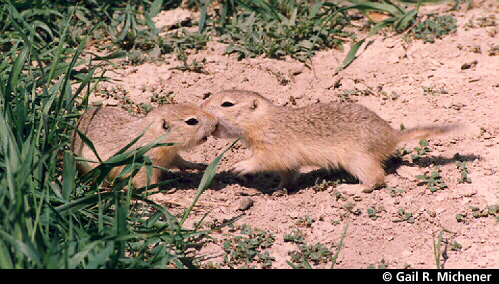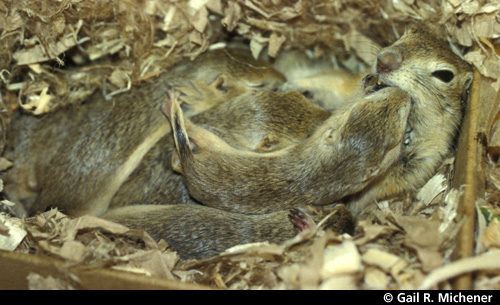 Although Richardson’s ground squirrels appear to live communally, a population of squirrels has a distinct social organization based on female kinship. The fundamental social bond in Richardson’s ground squirrels is between mother and offspring, particularly female offspring. Sons generally disperse as juveniles, whereas daughters settle near their natal site, forming fundamental social units based on lifetime kinship associations between mother-daughter and littermate sisters. Richardson’s ground squirrels do not defend a communal territory; instead each individual independently exhibits dominance over intruding non-kin.
Although Richardson’s ground squirrels appear to live communally, a population of squirrels has a distinct social organization based on female kinship. The fundamental social bond in Richardson’s ground squirrels is between mother and offspring, particularly female offspring. Sons generally disperse as juveniles, whereas daughters settle near their natal site, forming fundamental social units based on lifetime kinship associations between mother-daughter and littermate sisters. Richardson’s ground squirrels do not defend a communal territory; instead each individual independently exhibits dominance over intruding non-kin.
Female ground squirrels recognize their kin throughout their life, even after many months without contact such as during hibernation. Females tolerate the proximity of closely related female kin, including their mother, sisters, grandmother, daughters, granddaughters, aunts, nieces and female cousins. This tolerance does not extend to sharing the nest in which young are born and reared. During pregnancy each female establishes her own burrow system with 2 or 3 nest chambers in which she rears her offspring.

For the first month of life, infants come into contact only with each other and with the mother.
Typically, the interactions between familiar kin are more amicable and less antagonistic than interactions between unfamiliar non-kin. Juvenile siblings play together and may even sleep communally for a time, but these amicable interactions decline as the juveniles get older. By the age of 12 weeks, juvenile grounds squirrels are behaviorally indistinguishable from adults in their social interactions and use of space. Even so, juvenile females remain physically close to and amicable with their sisters and mother throughout life.
The main association between adult male and adult female ground squirrels is courtship and copulation. Females are in estrus for a few hours on one afternoon of one day of the year, during which time they tolerate the proximity of males. Thereafter, once the female is pregnant, she is intolerant of the proximity of any male, including her mates. There are no lasting pair bonds between adult males and adult females.
Male Richardson’s ground squirrels form no social associations with either sex. Except for the brief time as juveniles, all male-male interactions in Richardson’s ground squirrels are antagonistic, involving fights, chases, and sparring. Aggression between adult males is most intense during the mating season in spring. After the mating season, males restrict their movements to a small area, due in part to the aggressiveness of pregnant and lactating female ground squirrels. At no time are males dominant over females, even though they are physically larger.
Related Pages:
Reproductive Behavior
Habitat
Population Composition
Sources: PDFs of many of these articles can be downloaded from the Michener Publications page
- Michener, G. R. 1983. Spring emergence schedules and vernal behavior of Richardson’s ground squirrels: why do males emerge from hibernation before females’ Behavioral Ecology and Sociobiology, 14:29-38.
- Michener, G.R. 1981. Ontogeny of spatial relationships and social behaviour in juvenile Richardson’s ground squirrels. Canadian Journal of Zoology, 59:1666-1676.
- Michener, G.R. 1979. Spatial relationships and social organization of adult Richardson’s ground squirrels. Canadian Journal of Zoology, 57:125-139.
